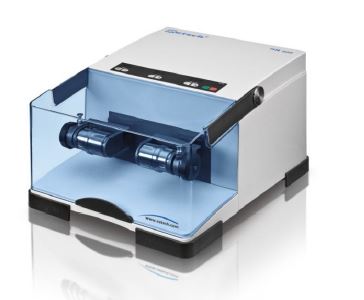MIXER MILLS (Retsch MM400), 100-240V, 50/60Hz
Valid Article
BONES MIXER MILLS (Retsch MM400)
Definition
The mixer mill MM 400 is a compact versatile bench-top unit, which has been developed specially for dry, wet and cryogenic grinding of small amounts of sample. It allows a final fineness level of 5 µm.
This model mixes and homogenizes the powders in a few seconds by powerful impact and friction grinding, up to 30 Hz.
It allows the efficient disintegration of cells in cell suspension for the extraction of DNA / RNA and proteins as well as the isolation of tissue bacteria tubes for an accurate diagnosis of infections.
In our contexts, it is used to grind bones in bacteriology laboratories.
Specifications
Quality Standards Comment
- Protective system IP30.
- CE Norms.
- Electromagnetic compatibility (EMC) Class B according to EN 55011
Components
- 1x mixer
- 2x R22.001.0016 Adapter for 4 wide mouth bottles 30 ml including 12 wide mouth bottles 30 ml
Technical specifications
- Electrical supply data 100-240 V, 50/60 Hz
- Power connection 1-phase
- Power consumption 185 W
Working conditions:
- 5°C to 40°C
- Maximum 80% humidity at temperature 31°C and 50% at temperature 40°C
- Maximum 2000 m above see level
- Requiered floor space: 400 x 500 mm
Dimensions
- w x H x D closed : 385 x 350 x 470 mm. Height is 640 mm with hood opened
- Weight: approximatively 27.5 kg
Instructions for use
Precautions for Use
- Used only for bones crushing and diagnostic of osteo-articular infections.
- The sample quantity should not be less than 25% of the milling cup volume.
- Ensure container is balanced with another container with the same weight (as for the centrifuge).
Maintenance
- Cleaning: Use only a cloth moistened with water and/or standard household cleaning agents if necessary. Do not use solvent-based cleaners.
- Maintenance: The MM 400 is maintenance-free. When used properly no maintenance and setting work need be carried out.
MSF requirements
Only for bacteriology laboratories working with bones samples.
Reserved to bacteriology programmes. Must be validated by the laboratory referent





![[ELAEMOGA101] (mixer mills, Retsch MM400) BALLS 5mm, inox, set of 200](/web/image/product.template/572505/image_256/%5BELAEMOGA101%5D%20%28mixer%20mills%2C%20Retsch%20MM400%29%20BALLS%205mm%2C%20inox%2C%20set%20of%20200?unique=8aede96)
![[ELAEMOGA102] (Retsch MM400) KIT 12BOTTLES wide mouth 30 ml and 4 ADAPTORS](/web/image/product.template/572508/image_256/%5BELAEMOGA102%5D%20%28Retsch%20MM400%29%20KIT%2012BOTTLES%20wide%20mouth%2030%20ml%20and%204%20ADAPTORS?unique=8aede96)
![[ELAEMOGA103] (Retsch MM400) KIT 12BOTTLES wide mouth 30 ml](/web/image/product.template/582376/image_256/%5BELAEMOGA103%5D%20%28Retsch%20MM400%29%20KIT%2012BOTTLES%20wide%20mouth%2030%20ml?unique=55231b1)